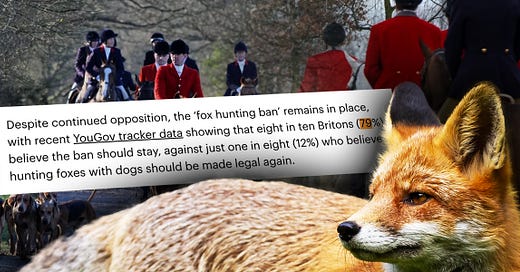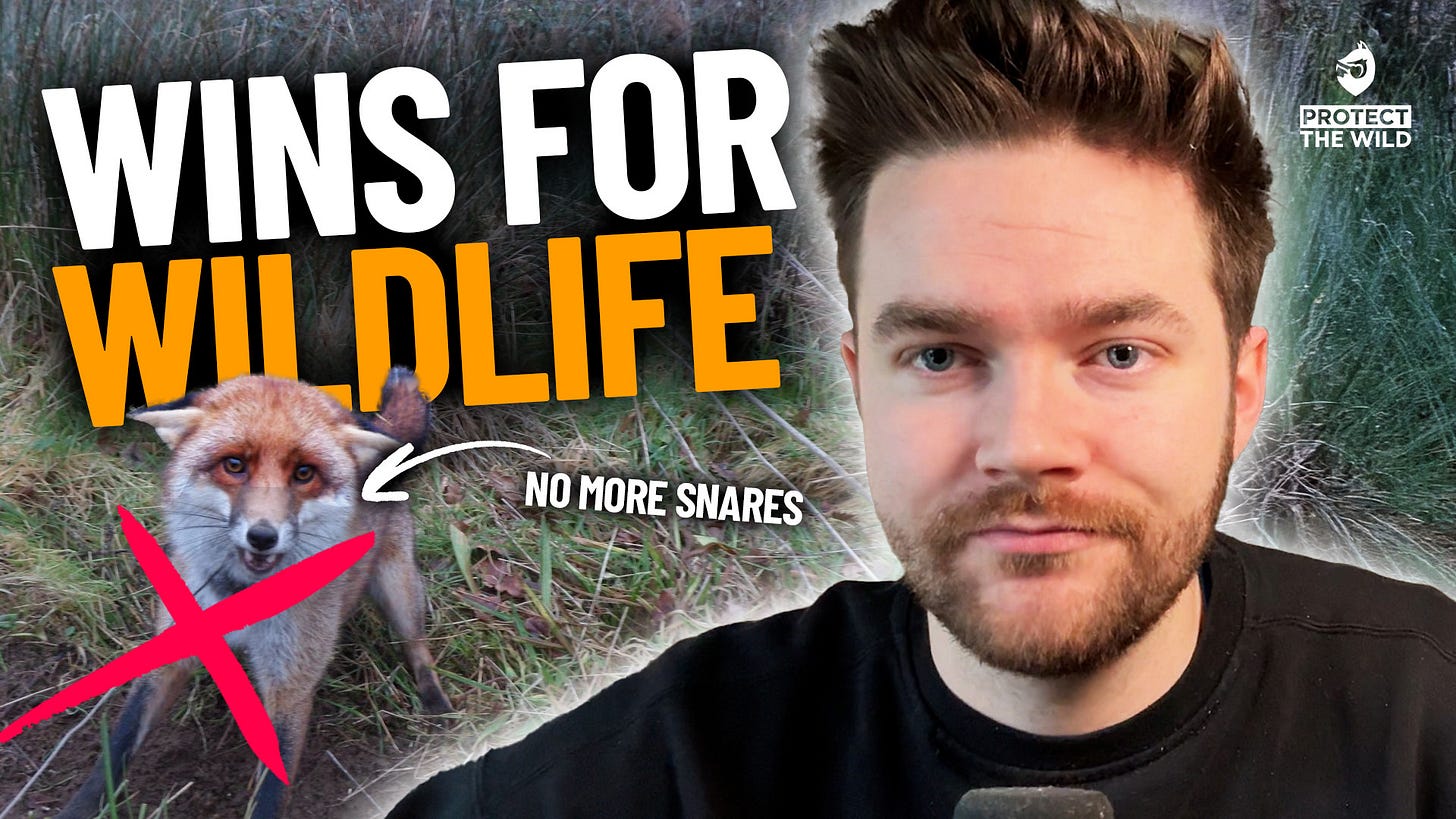YOUGOV: survey shows Brits' mixed views on hunting wildlife
But clear majority opposed to killing for 'sport'
A recent YouGov poll attempted to gauge the British public's views on hunting. The findings will be a blow to hunters who want to be recognised as a protected minority group in the UK so they can enjoy their pastime in peace. The poll results suggest that if the hunters' demand were decided by a group of their countrywide peers, the answer would be a decisive 'jog on'.
Outside of an overwhelming rejection of the acceptability of recreational hunting, YouGov's poll points to some areas where British people are more equivocal. Protect the Wild breaks it down.
No to killing for kicks
Highlighting its poll findings on 18 November, YouGov explained that a separate tracker data it maintains shows 79% of Britons want a fox hunting ban to remain in place, some two decades after the prohibition was first introduced via the Hunting Act 2004.
The tracker data chimes with other earlier surveys, which have repeatedly shown public support for keeping a ban on the cruel practice. Indeed, many people want to see the ban strengthened. As readers will know, Protect the Wild is calling for a proper ban on hunting, due to the law in its present form being littered with loopholes that hunts routinely exploit.
As YouGov highlighted, people rejected trophy hunting with even stronger gusto in its hunting survey, for which the organisation surveyed 2255 individuals in Great Britain in mid-November. 92% of respondents viewed trophy hunting as unacceptable. Moreover, 83% opposed allowing hunting for recreational purposes.
Taken together, the poll and tracker data point to the British public being staunchly against killing for kicks, a huge majority opposing the hunting of wild animals for the thrill of it.
Food-related hunting
The YouGov poll found people to be more accepting of hunting when it is related to food provision for humans. For instance, a sizable majority of people surveyed – 71% – believed hunting for food to be completely or somewhat acceptable. The question didn’t ask what species should be hunted and eaten, how many should be killed, or by whom though.
Meanwhile, a small majority of respondents also supported allowing farmers to hunt wildlife that they consider to be 'agricultural pests'. However, the majority on this was thin, with 53% of people strongly or somewhat supporting the idea. 36% of respondents either strongly or somewhat opposed farmers being able to hunt 'pests' and 11% were unsure either way.
Given the relentless rhetoric put out by farming lobbyists about the need to control 'pests' - an ill-defined collection of wild animals - the results are unsurprising, but do show that a significant section of the public is indeed hesitant about permitting farmers to persecute wildlife, even in the name of protecting agriculture. With food systems being the primary driver of nature loss globally, such caution is understandable.
By now, it is commonly recognised – including by many farmers – that the dominant agricultural practices of our time need reform to be considered nature-friendly. As an oft-cited Chatham House report noted, existing food production heavily relies on using inputs, such as pesticides, fertilisers, land, water, and energy, and "unsustainable practices" like monocropping, i.e. growing large amounts of the same crop year after year. It said:
"This has reduced the variety of landscapes and habitats, threatening or destroying the breeding, feeding and/or nesting of birds, mammals, insects and microbial organisms, and crowding out many native plant species."
The State of Nature Report 2023, meanwhile, pointed to farming, which occupies 70% of the UK's entire land area, as a leading cause of the country's nature loss. The report identified the climate crisis as another major driver. It soberingly warned that almost one in six wild species is threatened with extinction in Great Britain.
Considering all this, it is little wonder that the idea of allowing farmers to hunt wildlife they deem problematic is met with resistance by many. It's also possible that the farming industry's enthusiasm for the badger cull, which has seen well over 230,000 of the beloved mammals killed since 2013, wasn't far from these respondent's minds.

Words matter
If the questions above were posed to the likes of industry bodies like the Agriculture and Horticulture Development Board, they would likely point to their own survey findings that show high levels of trust in farming among the public.
There is likely to be another reason why some people gave a theoretical green light to farmers killing wildlife: YouGov's framing of the question, specifically its use of the word 'pest'. This word instantly condemns its subject as a menace who needs to be dealt with - one way or the other. The same is true of the phrase 'invasive species', which refers to wild animals and plants that have been displaced from their native homelands, usually thanks to human action. The word 'invasive' characterises its subject as someone who neither belongs nor is welcome, much like those damned 'pests'.
Funnily enough, YouGov also asked respondents whether hunting 'invasive species' is acceptable. 55% of respondents considered this acceptable, meaning the idea secured a similar level of support from people as approval for farmers hunting 'pests' did.
The word 'pest' is routinely used to describe animals like rabbits, foxes, and pigeons. It is perhaps no coincidence then that when YouGov asked respondents elsewhere in its poll about which particular animals people should and should not be allowed to hunt: pigeons (which species are not specifically named), rabbits, and pheasants (a bird released in vast numbers every year by the shooting industry) secured the highest levels of support for allowing hunting at 58%, 55% and 48%, respectively.
Knowing me, knowing you
In contrast, most respondents rejected the idea of allowing iconic animals like lions, elephants, whales, zebras, and chimpanzees, to be hunted. The YouGov poll did not provide any context when it asked people about the acceptability of hunting particular animals. But the iconic nature of these species groups makes them seem precious, exotic, and familiar, all at once, regardless of how much people actually know about the precarious conservation situation faced by many of the species in these groups.
British people are likely to consider pigeons, rabbits, and pheasants as familiar too - although perhaps distinctly non-exotic – but how much do we actually know about them?
Pigeons have long been the subject of contempt, despite the fact that they are intelligent, resilient, and affectionate. The YouGov poll only referred to them under this generic, catch-all name, but there are five Columbidae (pigeons and doves) species found in the UK. Woodpigeons are the most common, according to the RSPB. This bird was moved from Green to Amber on the UK's list of Birds of Conservation Concern in 2021. The change was due to the country holding a significant proportion of the Woodpigeon's European breeding population. Although this pigeon saw strong population increases between 1970 and 2010, its population has seen declines since then.
Of the five Columbidae species found in the UK, only two have a Green classification on the list of Birds of Conservation Concern. One of them is the so-called 'feral' pigeon, who are descendants of the Rock Dove. Studies show that they serve as important prey for the world's imperilled raptor species - making up a large percentage of the food of the UK's urban Peregrine population for example. Meanwhile, the Turtle Dove is the UK's most threatened Columbidae species. This bird's UK population has dropped by an estimated 98% since 1970, due to farming practices in the country and hunting elsewhere in parts of this migratory bird's range. Enormous efforts by multiple actors – farmers, conservationists, and policymakers – to recover the species have recently started to bear fruit, but Turtle Doves remain almost entirely confined to small areas of eastern England.
Nonetheless, similar stories of decline are all too common in the UK, with farmland bird populations overall dropping by 61% since 1970.

Impacts on ecosystems
Now, let's turn to rabbits, or more specifically the European rabbit (Oryctolagus cuniculus), a Mediterranean species brought to the UK by the Romans. The People's Trust for Endangered Species (PTES) has highlighted that rabbit populations in rural areas of the country declined by 67% between 1995 and 2022. Urban populations have also seen a decline of around 36% since 2004, according to PTES.
The situation is sufficiently dire for the mammals that people have been building "rabbit hotels" for them in areas where their absence would be detrimental to the wider landscape, as the Guardian reported in 2021. Natural England has explained that in an area of Norfolk and Suffolk known as the Brecks, the European rabbit is a keystone species that "holds together the entire ecosystem" because the animal's "grazing and digging activity keeps the ground in a condition that is perfect for sustaining other species that would otherwise move on – or die out."
As for the Common Pheasant, this 'naturalised non-native' can commonly be found in many parts of the UK. This is not because the country is a residence of the bird's choosing. Rather, it's because the shooting industry releases millions of non-native birds each year, precisely for the purpose that riles Brits the most, according to the YouGov survey, namely killing them for fun. The pheasant's presence poses a risk to the country's ecological systems. But there is an obvious solution to this problem: stop releasing them in the first place.
Gender divide
Finally, it is interesting that the survey found that women consistently see hunting as less acceptable than men.
A clear gender divide exists in attitudes towards hunting. While 45% of men see hunting with guns as acceptable, only 19% of women do; and while men divide 65% to 28% in favour of hunting overpopulated species being okay, women divide 49% to 41% against it being acceptable.
These are findings that do appear to be reflected in the ‘real world’, where shooters are predominately male as are the majority of senior hunt staff. It also appears to somewhat reflect the Protect the Wild supporter base - many of our most regular and passionate commenters here on Substack, for example, are indeed women.
Regardless of gender, though, most people agree that hunting animals is unacceptable. Instead, it would be preferable to prioritise non-lethal ways to co-exist with wildlife, so we can safeguard the wild organisms that manage to live in one of the most nature-depleted countries on Earth.
Need some positivity? Our latest video features only the wins and successes from the last few weeks! It’s the first of our monthly recap videos that highlights only the good!







I am not sure I have time for YouGov 'surveys' as if they are truly 'random' they are speaking to quite possibly many who are not 'educated' on the true facts of which they are being asked to judge. I believe this to be the case in this survey. Many are not qualified to make decisions based on what they know, it is more what they 'imagine' to be the case when in fact they have no idea but easily give opinions based on 'indoctrination' such as 'trusting farmers to know all in the countryside'!
All very good points very well made.
All campaigns are about getting their word to those who are not engaged in the fight, in this case, wildlife crimes. The general public have views and they need to be made aware of exactly what’s going on under their noses.
For those who find these vile activities acceptable…… SHAMEFUL!!!!! If they would do these horrific things to their children then they shouldn’t DO IT TO ANY LIVING CREATURE!!!!